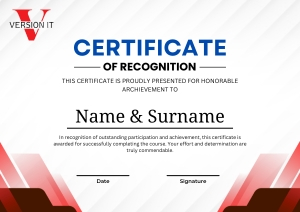Home > Courses > Full Stack Course > Mongo DB Course
Mongo DB Training in
Hyderabad
A modern technology stack for developing websites includes MongoDB Training in Hyderabad at its core. The abbreviation for Express.js, Angular, Node.js, and MongoDB is MEAN.. A NoSQL database, namely MongoDB, easily incorporates into this stack offering a robust, expandable and JSON-esque document architecture.
16 Modules
with Certifications
Certificate
After Completion
English
Language
One will, therefore, realize that choosing a MongoDB Course in a Version IT Training Institute is rewarding. Specialized lecturers assist students in understanding the specific details of version control software such as Git, which improves coding cooperation. A complete skill set made of practical examples and practical training effortlessly combines version control practice with professional software development.
What Do You Learn From This Course?
You will get an outline of this Java Framework. The first is how the database is created in the world of MongoDB. This is followed by building and storing documents in collections. Get trained on how to drop databases and collections and explore the complex field of crud operations. Learn how to include Javascript files and arrays for documents and advance your reading skills as well as querying. Know the power of these operators as $lt$ and $gt$ in reading a document, as well as revealing mysteries of updation and deletions.
Discover the world of indexes and ObjectIds; examining how they are made, affected, and located. Explore what are the good things and bad things about MongoDB’s ObjectId feature. Try aggregate(), distinct(), or count() queries. Dive into the finer details of arranging documents and adhere to a few basics related to data modeling by referring and embedded documents. Last but not least, unfold the relationship complications of Mongo, being a simple, One-To-One Relationship, One-To-Many Relationship, Many-To-Many Relationship connections.
Finally, Mongodb covers all aspects of development using server-side Javascript. This intensive course builds a strong base to succeed in today’s fast-moving world. Through this process, participants learn essential skills to facilitate building robust, highly functioning apps.
Topics You will Learn
Getting started with MongoDB
- Execution of a JavaScript file in MongoDB
- Making the output of find readable in shell
- Complementary Terms
- Installation
- Basic commands on mongo shell
- Hello World
CRUD Operation
- Create
- Update
- Delete
- Read
- Update of embedded documents
- More update operators
- “multi” Parameter while updating multiple documents
Getting database information
- List all collections in the database
- List all databases
Querying for Data (Getting Started)
- Find()
- FindOne()
- limit, skip, sort and count the results of the find() method
- Query Document – Using AND, OR and IN Conditions
- find() method with Projection
- Find() method with Projection
Update Operators
- $set operator to update specified field(s) in document(s)
Upserts and Inserts
- Insert a document
Collections
- Create a Collection
- Drop Collection
Aggregation
- Count
- Sum
- Average
- Operations with arrays
- Aggregate query examples useful for work and learning
- Match
- Get sample data
- Remove docs that have a duplicate field in a collection (dedupe)
- Left Outer Join with aggregation ( $Lookup)
- Server Aggregation
- Aggregation in a Server Method
- Java and Spring example
Indexes
- Index Creation Basics
- Dropping/Deleting an Index
- Sparse indexes and Partial indexes
- Get Indices of a Collection
- Compound
- Unique Index
- Single field
- Delete
- List
Bulk Operations
- Converting a field to another type and updating the entire collection in Bulk
2dsphere Index
- Create a 2dsphere Index
Pluggable Storage Engines
- WiredTiger
- MMAP
- In-memory
- mongo-rocks
- Fusion-io
- TokuMX
Pluggable Storage Engines
- WiredTiger
- MMAP
- In-memory
- mongo-rocks
- Fusion-io
- TokuMX
Java Driver
- Fetch Collection data with condition
- Create a database user
- Create a tailable cursor
Python Driver
- Connect to MongoDB using pymongo
- PyMongo queries
- Update all documents in a collection using PyMongo
Mongo as Shards
- Sharding Environment Setup
Replication
- Basic configuration with three nodes
Mongo as a Replica Set
- MongoDB as a Replica Set
- Check MongoDB Replica Set states
MongoDB – Configure a Replica Set to support TLS/SSL
- How to configure a ReplicaSet to support TLS/SSL?
- How to connect your Client (Mongo Shell) to a ReplicaSet?
Authentication Mechanisms in MongoDB
- Authentication Mechanisms
MongoDB Authorization Model
- Built-in Roles
Configuration
- Starting mongo with a specific config file
Backing up and Restoring Data
- Basic mongodump of local default mongod instance
- Basic mongorestore of local default mongod dump
- mongoimport with JSON
- mongoimport with CSV
Upgrading MongoDB version
- Upgrading to 3.4 on Ubuntu 16.04 using apt
Let Your Certificates Speak

- Gain expertise by earning a MongoDB certification while you become an expert in the MEAN stack.
- Certifications improve your programming profile and are accepted across the world.
- Certificates are issued upon the course's conclusion.
All You Need to Start this Course
- A strong grasp of JavaScript, which is necessary for both client-side (Angular) and server-side (Node.js) development.
- Basic familiarity with Node.js.
- Knowledge of the Node.js web application framework, Express.js.
- Basic understanding of Angular.
Testimonials




Still Having Doubts?
MongoDB indexing speeds up the database's search and retrieval of data, improving query performance. Understand how to create and use indexes correctly.
A Node.js and MongoDB ODM (Object Data Modelling) library is called Mongoose. Simplified MongoDB interfaces and a schema-based application data modelling methodology are provided.


